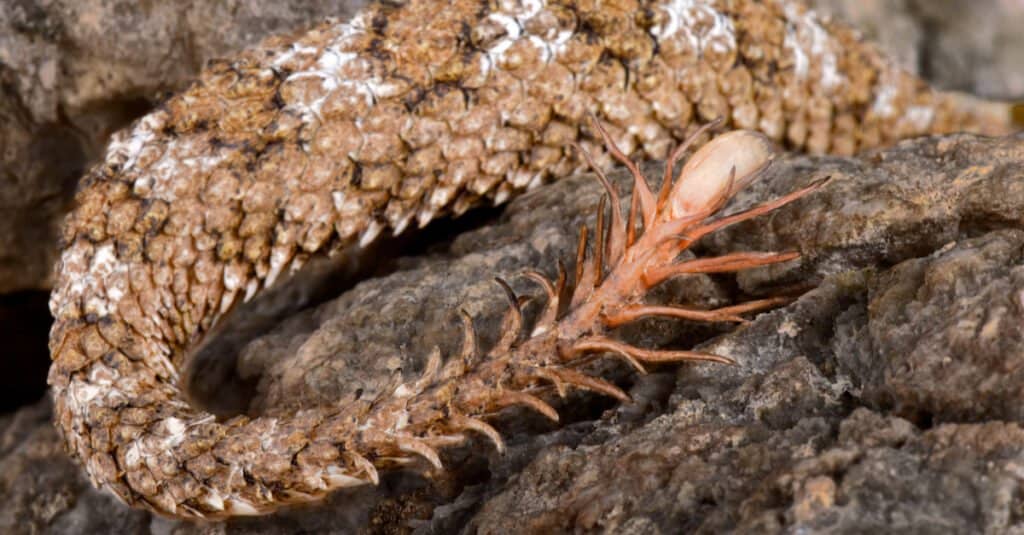Spider-Tailed Horned Viper
.jumbotron {
background-image: url(“https://a-z-animals.com/media/2022/02/Spider-tailed-Horned-Viper-header-400×300.jpg”);
}
}
@media only screen and (min-width: 641px) and (max-width: 920px) {
.jumbotron {
background-image: url(“https://a-z-animals.com/media/2022/02/Spider-tailed-Horned-Viper-header-470×370.jpg”);
}
}
@media only screen and (min-width: 921px) {
.jumbotron {
background-image: url(“https://a-z-animals.com/media/2022/02/Spider-tailed-Horned-Viper-header.jpg”);
}
}
Spider-Tailed Horned Viper
Pseudocerastes urarachnoides
They like to hide in crevices on the sides of cliffs, waiting for prey.
Spider-Tailed Horned Viper Scientific Classification
- Kingdom
- Animalia
- Phylum
- Chordata
- Class
- Reptilia
- Order
- Squamata
- Family
- Viperidae
- Genus
- Pseudocerastes
- Scientific Name
- Pseudocerastes urarachnoides
Read our Complete Guide to Classification of Animals.
Spider-Tailed Horned Viper Conservation Status
Spider-Tailed Horned Viper Facts
This post may contain affiliate links to our partners like Chewy, Amazon, and others. Purchasing through these helps us further the A-Z Animals mission to educate about the world’s species..

Discover alligator-eating snakes, spiders larger than your phone, and 1000 more incredible animals in our daily FREE email.
.photo-gallery {
–margin: 0px auto 0px;
–padding: 0px 0px 0px 0px;
}
.gallery-link {
background-image: url(“https://a-z-animals.com/media/2022/02/Spider-tailed-Horned-Viper-header-1024×535.jpg”);
background-repeat: no-repeat;
background-size: cover;
background-position: center;
height: 500px;
justify-content: center;
text-align: center;
align-items: center;
display: flex;
border: 2px solid #000;
}
.gallery-link img {
height: 50%;
}
@media only screen and (max-width: 768px) {
.gallery-link {
height: 300px !important;
}
}
View all of the Spider-Tailed Horned Viper images!
With the finesse of a fly-fisherman, the spider-tailed horned viper lures its feathered prey to its doom.
The spider-tailed horned viper is a venomous snake that inhabits a small area in western Iran. Scientists first discovered it in 1968 but thought the tail was a random mutation. Yet, it was 2006 before scientists had a live specimen to examine and determined that the unique tail indicated they had a new species.
Spider-Tailed Horned Viper Amazing Facts
- The species uses a caudal lure (the tail!) that looks like a spider – a phenomenon known as feeding mimicry.
- These vipers blend into their environment well enough that birds land on them, so focused on the “spider” that they do not see the snake until it’s too late.
- They can strike in .2 seconds.
- Many of the local birds have figured out the viper’s game – it appears that only the visiting birds fall prey to its charms.
Spider-Tailed Horned Viper Location
They have only been found in a few areas in western Iran and are rare enough that CITES agreed to add them to Appendix II to restrict international trade.
button.pulse {
transform: scale(1); animation: pulse 2s infinite;
box-shadow: 0 0 0 0 rgba(11, 247, 25, 1);
}
@keyframes pulse {
0% { transform: scale(0.90); box-shadow: 0 0 0 0 rgba(11, 247, 25, 0.5); }
60% { transform: scale(1); box-shadow: 0 0 0 15px rgba(11, 247, 25, 0); }
100% { transform: scale(0.90); box-shadow: 0 0 0 0 rgba(11, 247, 25, 0); }
}
Spider-Tailed Horned Viper Scientific Name
The spider-tailed horned viper, or Pseudocerastes urarachnoides, is part of the Viperidae family and means false horned, spider-like tail. Vipers are a family of venomous snakes with retractable fangs that inject venom deep into their prey. They are present in most parts of the world except Siberia, Ireland, the arctic circle, and Australia.
Pseudo = false
cerastes = false
ura = tail
arachna = spider
ides = like
Spider-Tailed Horned Viper Population & Conservation Status
The IUCN listed it as “data deficient” because there isn’t enough data to determine whether they are threatened or endangered. Its range is small enough that there’s a concern among the scientific community. Scientists seek more information and want to have a more detailed study done.
Appearance & Description: How to Identify the Viper
These vipers are unique-looking. Their eyes are tan-colored with vertical pupils. They have rough skin with keeled scales that blends well with the granite of their home range; and scales that extend upwards from the eyes, forming “horns.” Their most unique feature is their tail: they have a bulbous, fleshy-looking end with long, thin scales that dangle from it.
Photos & Videos of the Spider-tailed Horned Viper
Video showing the viper catching a bird, using its tail as a lure.

reptiles4all/Shutterstock.com

reptiles4all/Shutterstock.com

reptiles4all/Shutterstock.com
Venom: How Dangerous is a Spider-tailed Horned Viper?
It is venomous and will strike when threatened. However, it doesn’t seem to be aggressive towards people unless cornered.
Behavior & Humans
This viper is an ambush predator with a twist. It wiggles the end of its tail, making it appear alive. Its favorite food is of the feathered variety, and several videos show a spider-tailed horned viper luring a bird close enough to strike. However, it doesn’t restrict its diet to birds – the spider-tailed horned viper also hunts arthropods, rodents, and lizards.
People have become its most significant predators, and its unique hind end has attracted collectors.
View all 186 animals that start with S
Spider-Tailed Horned Viper FAQs (Frequently Asked Questions)
What are their natural predators?
We don’t know yet.
Do they hatch with that spider-shaped tail?
No, their tail develops into the lure as they grow.
Are they venomous?
Yes! Like all snakes in the Viperidae family, they are venomous.
How do they hunt?
They are ambush predators; they wait for their food to come to them. Then, using the spider-shaped tail, they wiggle it to make it look like a juicy bug.
Are spider-tailed horned vipers aggressive?
They don’t appear to be but will defend themselves if cornered.
Where do spider-tailed horned vipers live?
They live in the rocky, arid hills of western Iran.
What do spider-tailed horned vipers eat?
Their favorite food is birds, but they will also eat lizards, rodents, and arthropods.
Does their tail break off like rattlesnake rattles?
Not on purpose. Researchers reported seeing a few determined birds pecking hard enough to make off with the “spider,” leaving the snake to resort to other hunting methods.
Sources
- IUCN, Available here: https://www.iucnredlist.org/species/164664/5916336#assessment-information
- CITES, Available here: https://cites.org/eng/app/appendices.php
- CITES, Available here: https://cites.org/sites/default/files/eng/com/AC/30/Inf/E-AC30-Inf-13.pdf
- The Reptile Database, Available here: https://reptile-database.reptarium.cz/species?genus=Pseudocerastes&species=urarachnoides
- Herpetologica, Available here: http://www.herpetologica.org/BAHE/BAHE27(1)_%5B240%5D_04_HNat11.pdf
- Research Gate, Available here: https://www.researchgate.net/publication/308415570_Annual_activity_pattern_of_pseudocerastes_urarachnoides_squamata_ophidia_viperidae_with_notes_on_its_natural_history
- Research Gate, Available here: https://www.researchgate.net/publication/280348452_Avian_deception_using_an_elaborate_caudal_lure_in_Pseudocerastes_urarachnoides_Serpentes_Viperidae
- National Library of Medicine, Available here: https://pubmed.ncbi.nlm.nih.gov/33540884/
















